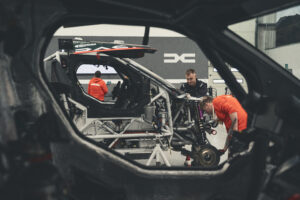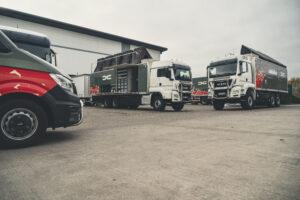Dakar needs no introduction – it is one of the most grueling and gut-wrenching rallies in the world. Forget winning, simply taking a shot at the Dakar Rally is an accomplishment. Making its debut in January 2025, Dacia’s Dakar team comes across as down to earth and hoping to do their best competing in the Ultimate T1+ category. However, the Sandrider, Dacia’s purpose-built rally raid vehicle, doesn’t necessarily echo the team’s humble outlook. The purpose-built two-metric-ton all-black rally car looks hungry and primed to take on towering dunes in what is one of the most arid deserts in the world.
Dacia might be a new face to Dakar, but Renault Group and Prodrive are anything but beginners. Even at first glance, the Sandrider comes across as intimidating with its tubular chassis and exposed carbon-fiber construction. Built entirely by Prodrive, the design is based on the Dacia Manifesto concept from 2022. There’s not much in the way of design aesthetics to speak of – everything you see is present because it needs to be. The anti-reflective paint on the upper dashboard is a technique borrowed from the aviation industry to aid driver visibility, and the anti-infrared pigments directly integrated with the vehicle’s carbon body panels keep the cabin temperature bearable – for which a patent has been filed.

Powering Dacia’s Dakar dream is a 3.0-liter twin-turbo, direct-injection V6 engine that develops 360hp at 5,000rpm and 539Nm at 4,250rpm. The Nissan VR30DDTT unit might be familiar to some. Yes, it is the same powerplant that is tucked inside the 400Z sportscar. The same engine is also a direct descendant of the famed VR38 – the powerhouse in the R35 GT-R. Speaking to PMW on the engine choice, Philip Dunaban, technical director, Dacia Raid Rally, said there were constraints to finding a V6 powertrain within Renault Group: “Nissan’s relationship with the Renault group is not what it used to be, but there’s still links between them.”

Mounted in a front-mid position, the engine is mostly standard with stock internals. However, it gets an uprated forced induction system. The dry sumped motor features the standard crank, block and even the stock intake system, as Dacia states that it performs well as it is. Meanwhile, the transmission is a 6-speed sequential unit from Sadev. BF Goodrich is assigned to supply the massive 37in tires, while the brakes and clutch are courtesy of Alcon with dampers coming from Reiger. Lastly, the synthetic fuel for the Sandrider comes from Aramco.
The cabin continues the same design ethos, and again this is for a reason. There are no heated chairs with massage function but the Sabelt seats are finished in a unique anti-bacterial fabric that self-regulates humidity, and the seat attenuators, developed by Prodrive, can absorb impact during landings. There’s also a dedicated main and secondary navigation for the driver and the co-driver, so they don’t get lost. Overall, Dacia’s engineers placed emphasis on the needs of drivers and co-drivers and as a result the dashboard is modular – it lets each crew member adapt the ergonomics and layout of certain features to their own requirements.

Dacia’s logistics and preparation for the Dakar is as interesting as the Sandrider’s design and involves 62 support staff and 25 support vehicles. These include five purpose-built trucks, three vans, nine motorhomes, a Duster, a Nissan Navara and, of course, a trusty Toyota Land Cruiser. The purpose-built trucks carry everything, from sleeping tents, supplies, parts, a makeshift garage, tires and two massive generators to a 350-liter water tank and two washing machines even. Strange, but it’s not rocket science what two weeks in the Saudi Arabian desert can do to your white t-shirts!

The Sandrider initially showed its mettle at the Millbrook proving ground in the UK followed by extensive testing in the South of France. But the real litmus test was carried out when Dacia entered the Rallye du Maroc in October of this year. A precursor to the Dakar, the Rallye du Maroc is filled with dirt tracks, sand, stones and dunes across a sprawling desert course spanning 2,468km. The Sandrider managed to secure an impressive one-two finish on its first ever outing, yet the team, headed by team principal Tiphanie Isnard, remains humble, hoping to do their best in January. The venerable line-up of drivers includes Sébastien Loeb, Cristina Gutierrez Herrero and Nasser Al-Attiyah.
Learnings from Morocco were crucial for the team. It showcased the Sandrider’s pace while also helping the team identify minor chinks. “Morocco showed how certain aspects of the cooling systems we needed to improve, but it’s no radical change” said Dunaban, with the team able to iron out issues particularly related to cooling fans. “There are elements that are more on the reliability side where need to do some work which we contained in Morocco, but we need to work on them,” he added.

The 2025 Dakar Rally will be Dacia’s first shot at a motorsport event of such a stature, but the outlook of the team and the Sandrider itself belies this. Despite attaining impressive results in Morocco, it is impossible to find complacency anywhere within the team. Instead, they have moved on and are busy prepping the Sandrider with updates and tweaks to replicate Rallye du Maroc on a slightly bigger stage.
It would be quite something if the team manages to repeat its early success. Finishing on top at Dakar is the stuff of dreams. Even sweeter when it’s your debut.



